Mawita’mkw (a place we can gather)
Mawita’mkw, an Indigenous gathering space, is located on the first floor of the Wallace McCain Student Centre (Room 130).
The space serves as a learning and gathering space for Indigenous students and community members.
Mawita’mkw is adorned with Indigenous artwork and a library filled with Indigenous literature.*
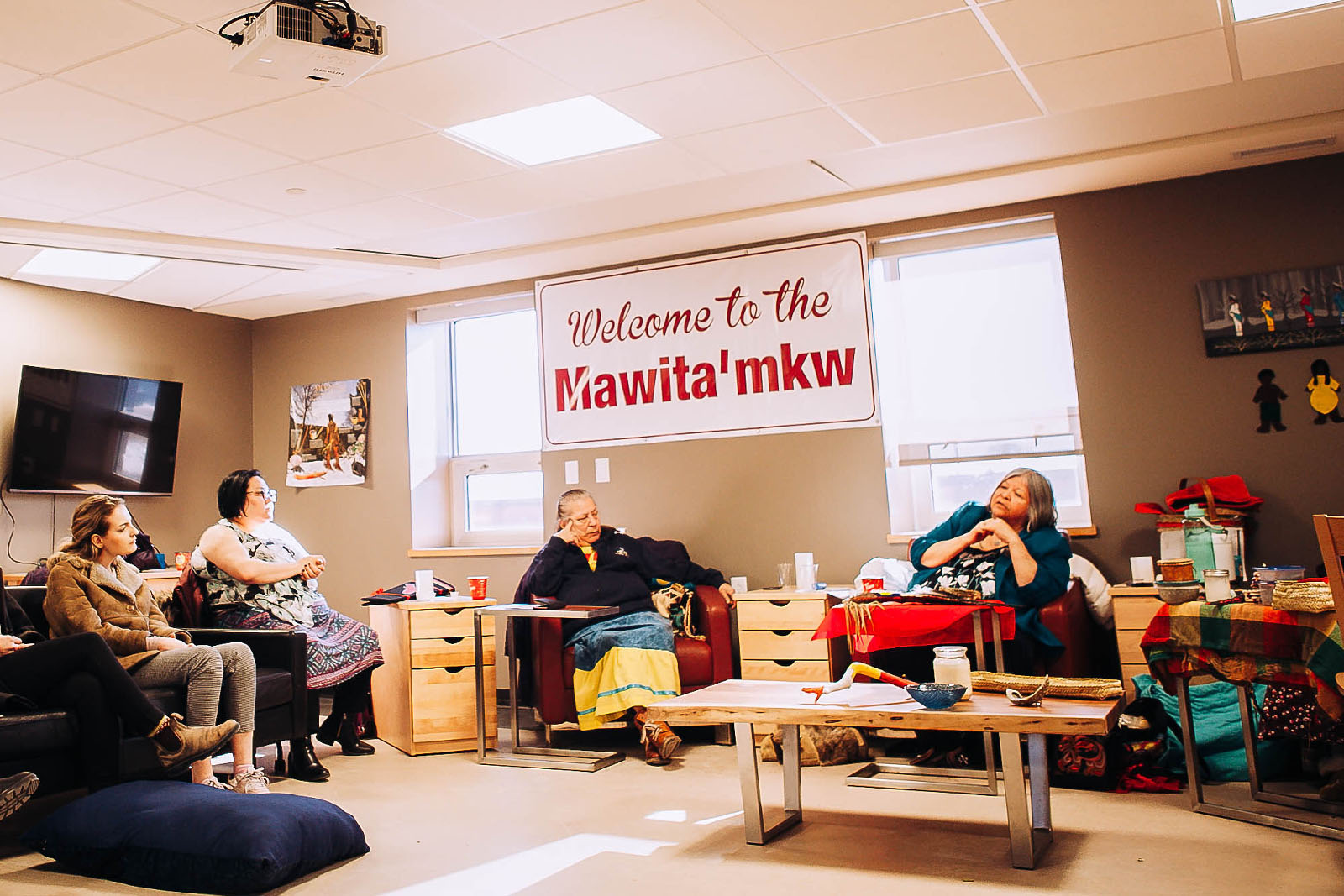
*Indigenous art work donated by Dr. Robert Campbell and Dr. Christl Verduyn. Indigenous literature graciously provided by Dr. Christl Verduyn.
"Having a designated space such as Mawita’mkw will help encourage dialogue and understanding in our University and wider community."
— Doreen Richard, former Indigenous affairs co-ordinator, at the official opening of Mawita’mkw on Sept. 29, 2016
University Sweat Lodge and tipi
The Sacred Sweat Lodge, constructed under the direction of Mi'kmaw elders, holds Sweat Lodge ceremonies during the year and during special events.
Located near the Sweat Lodge, a tipi structure can accommodate a fire pit and serves as a teaching and gathering space on campus.
Both are located behind Colville House on York Street.
Questions? Email indigenous@mta.ca
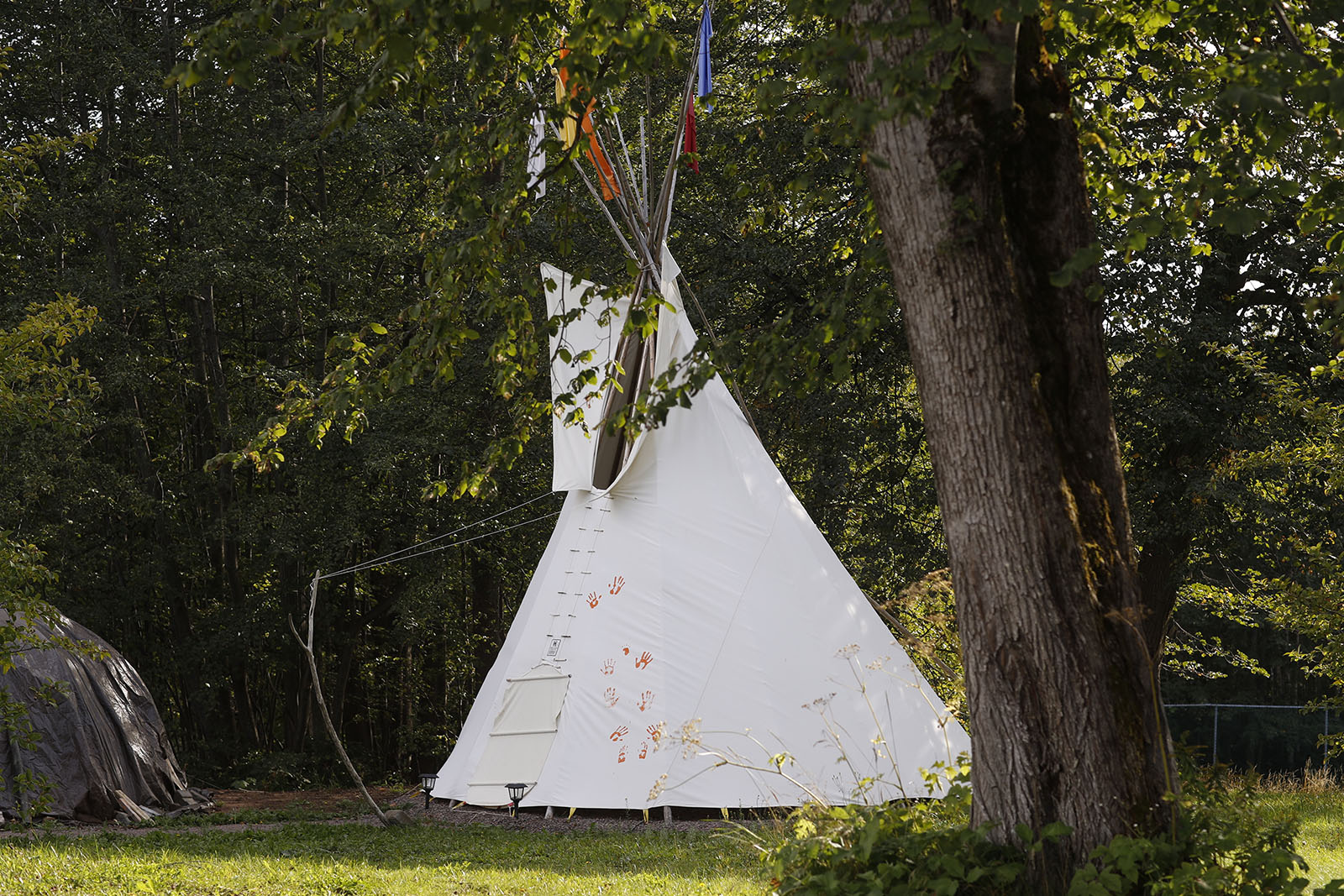
Mount Allison University Indigenous Gardens
In partnership with the Department of Geography and Environment
The Mount Allison University Indigenous Gardens, developed in 2019, are spread throughout the University’s campus.
Based on collaborative planning with local Elders, Knowledge Holders, and University students, faculty, and staff, several garden initiatives resulted in the development of the Medicine Wheel Garden, the Sacred Medicine Gardens, and the Three Sisters Garden.
Elders and Knowledge Holders:
- Elder Doreen Richard
- Knowledge Holder Nicole Dube

Medicine Wheel Garden
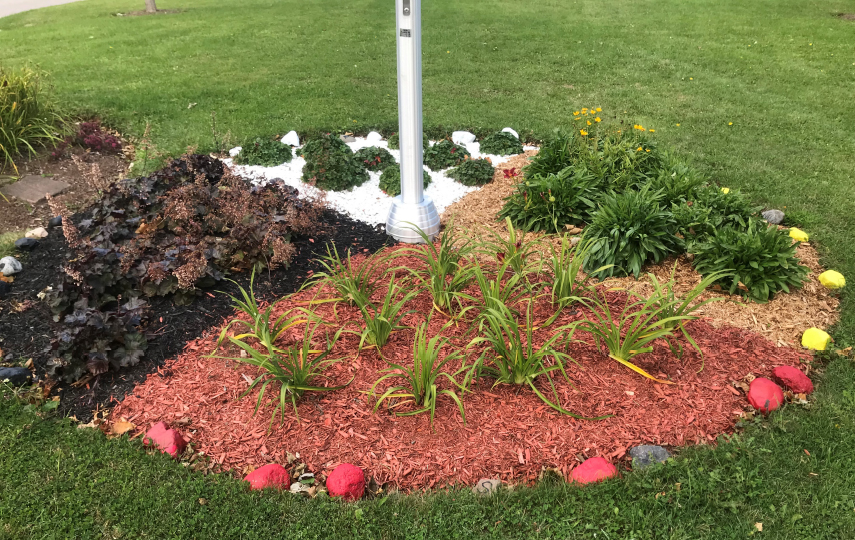
The Medicine Wheel Garden is a very important symbol and teaching tool used in Indigenous cultures.
The Medicine Wheel teaches about relationships, balance, interconnectedness, and unity. Each of the four directions of the Medicine Wheel are coloured, and those colours and placements can differ among nations.
The Medicine Wheel Garden on campus situates white in the north, yellow in the east, red in the south, and black in the west.
The Medicine Wheel circle can represent the sun and the seasons, beginning in the East, where the sun rises, and following a clockwise direction.
There are many teachings associated with the Medicine Wheel, often shared by Elders and Knowledge Holders.
Sacred Medicine Gardens
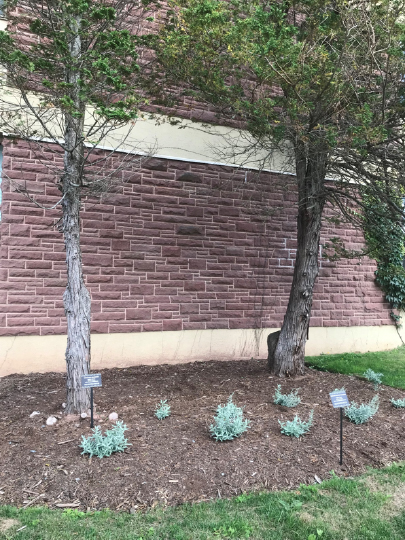
Tmawey (tobacco), Kjilmu’loqsitk (sage), Qaskuki (cedar) and Oelimageoel Msigol (sweetgrass) are considered sacred medicines by the Mi’kmaq and other Indigenous nations.
Across campus you can find Kjilmu’loqsitk (sage), Qaskuki (cedar), Oelimageoel msigol (sweetgrass) and Tmawey (tobacco).
- Tmawey (tobacco) acts as the main activator of all plant spirits and can be used during a smudge ceremonies. Tmawey is often also used as an offering and in ceremony. Tmawey allows for the communication with the spirit world and is used to express gratitude for the help that our spirit guides provide us.
- Kjilmu’loqsitk (sage) is often used through smudging to prepare for ceremonies and teachings. It is often used to remove negative energy and to help clear troubles from the mind. Kjilmu’loqsitk can also be used to cleanse homes and objects.
- Oelimageoel msigol (sweetgrass) is used in smudging, ceremonies and in prayer. Oelimageoel msigol is commonly dried and braided. As it is burned, it is used to attract positive energy.
- Qaskuki (cedar) is used for purification purposes. Qaskuki can also be used medicinally and in a healing bath. When cedar is placed in a fire with tobacco it makes a crackling sound, which calls the attention of the spirits to the offering of the tobacco. When fasting and during sweat lodge ceremonies cedar is used as a form of protection.
Three Sisters Garden
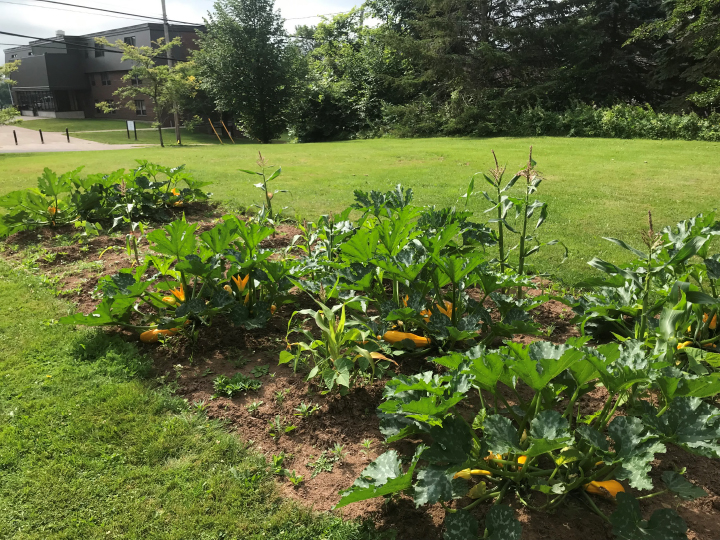
The Three Sisters Garden is located near the University’s Sweat Lodge.
The Three Sisters Garden demonstrates an Indigenous agricultural technique and shows how some plants grow better when placed together, much like the way people can accomplish more when working together.
The Three Sisters Garden uses traditional gardening techniques that consists of three separate plants that work together to increase productivity. Corn, beans, and squash are known as the three inseparable sisters that grow together.
When planting a Three Sisters Garden, the corn is planted first, and its stalk is used as a support for the beans to grow. The squash utilizes the space on the lower ground and grows along the garden bed. The squash keeps the moisture in the soil and acts as a natural aide in the prevention of weeds. The beans fix nitrogen for all of the sisters.
Signage
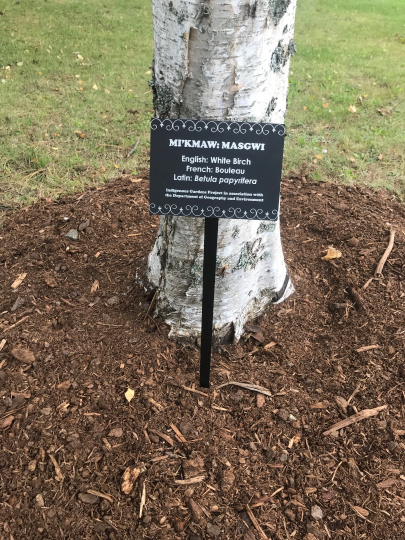
The plant species that can be found on campus with our signage are as follows:
Mi’kmaw: Epsemusi
English: Mountain Ash
French: Sorbier d’Amérique
Latin: Sorbus Americana
The Mi’kmaq use the inner bark of the Epsemusi steeped in water as a treatment for high blood pressure and stomach pains.
Mi’kmaw: Qaskuki
English: Cedar
French: Cèdre
Latin: Thuja occidentailis
The Mi’kmaq use Qaskuki in steam baths to treat rheumatism, arthritis, colds, congestion and gout. Externally it is used to make a poultice for swollen feet, fever and burns. Qaskuki is one of the four sacred medicines (see Sacred medicines garden, above)
Mi’kmaw: Oelimageoel msigol
English: Sweetgrass
French: Foin D’odeur
Latin: Hierochloe odorata
The Mi’kmaq use Oelimageoel msigol in ceremonies as it has great spiritual value in Indigenous culture. It is used for smudging, cleansing and purifification purposes. It was also boiled and drank as a tea. Oelimageoel msigol is one of the four sacred medicines. (see Sacred medicines garden, above)
Mi’kmaw: Tmawey
English: Tobacco
French: Tabac
Latin: Nicotiana spp
When burned, Tmawey’s smoke can be used to treat earaches and asthma. Tmawey is one of the four sacred Mi’kmaq medicines. (see Sacred medicines garden, above)
Mi’kmaw: Kjilmu’loqsitk
English: Sage
French: Sauge
Latin: Artemisia ludoviciana
Kjilmu’loqsitk is one of the four sacred Mi’kmaq medicines and is used for healing and purifying people. It is also used to help clear bad spirits. (see Sacred medicines garden, above)
Mi’kmaw: Masgwi
English: White Birch
French: Bouleau
Latin: Betula papyrifera
Masgwi’s is used by the Mi’kmaq for building canoes, wigwams, and baskets. The Masgwi sap creates a jell like consistency that can be used to lower blood pressure.
Mi’kmaw: Gawatgw
English: Spruce
French: Épicéa
Latin: Picea spp
The Mi’kmaq use Gawatgw sap from the inner bark of the tree to treat mouth sores and to help close up wounds. Gawatgw roots are used as thread to help hold together the birch bark canoes and baskets.
Mi’kmaw: Snawei
English: Sugar Maple
French: Érable
Latin: Acer saccharum
The Mi’kmaq use the inner bark of Snawei in teas to treat coughs and digestive discomfort. Snawei sap can be made into maple syrup and is a liver tonic and kidney cleanser. For sources of hydration, the Snawei water can be ingested.
Mi’kmaw: Mimgwaqanimusi
English: Oak
French: Chêne
Latin: Quercus spp
The inner bark of Mimgwaqanimusi is used by the Mi’kmaq to treat chronic diarrhea, sore throats, poison-ivy rash and burns.
Mi’kmaw: Piesgmin, Wikun, Ejgujg
English: Corn, Beans, Squash
French: Blé d’Inde, Haricots, Courge
The main uses for these plants were for sustenance and nutrients. (see Three Sisters Garden above)
Mi’kmaw: Atu’omgemin
English: Strawberry
French: Fraise
Latin: Fragaria spp
Atu’omgemin leaves are used by the Mi’kmaq in tea as nerve tonic, to treat bladder and kidney ailments, jaundice, scurvy, diarrhea, stomach-aches, and gout. The leaves can also be chewed for the medicinal benefits. The roots, leaves and berries could be steeped in water to make a blood purifying medicine and act as a blood building agent. The plant could also be used to help treat urinary tract infections.
Mi’kmaw: Guow
English: Red Pine
French: Pin
Latin: Pinus resinosa
Guow bark, twigs, and needles are used in tea by the Mi’kmaq to treat colds and kidney ailments.
Mi’kmaw: Puseo’gsis
English: Tamarack
French: Mélèze
Latin: Larix laricina
Puseo’gsis bark is used in tea by the Mi’kmaq as laxative, tonic, diuretic for jaundice, rheumatism and skin ailments. The tea can be gargled to treat sore throats. Puseo’gsis is also used as poultice on sores, swellings and burns. Puseo’gsis gum can be chewed to treat indigestion.
Sources
- MI’KMAQ MEDICINES Remedies and recollections by Laurie Lacey. Second Edition.
- Plant Identification Study by Union of NB Indians. May 08-Jul 13 2000. Saint John NB. (Source from Nicole Dube)
- http://www.northernc.on.ca/indigenous/four-sacred-medicines/
- Kimmerer, R.W. 2013. Braiding Sweetgrass: Indigenous Wisdom, Scientific Knowledge, and the teachings of plants. Milkweed Edition.

